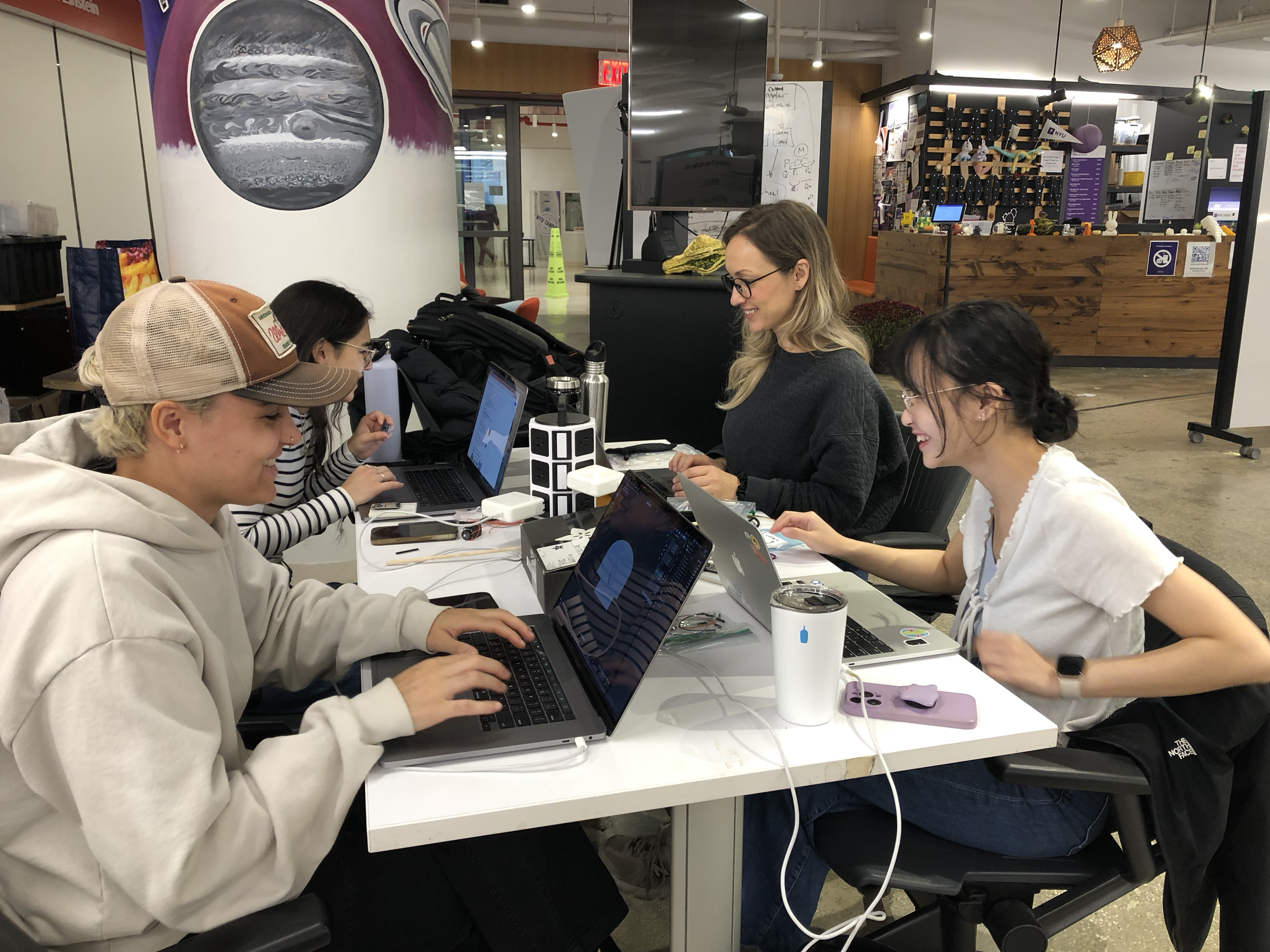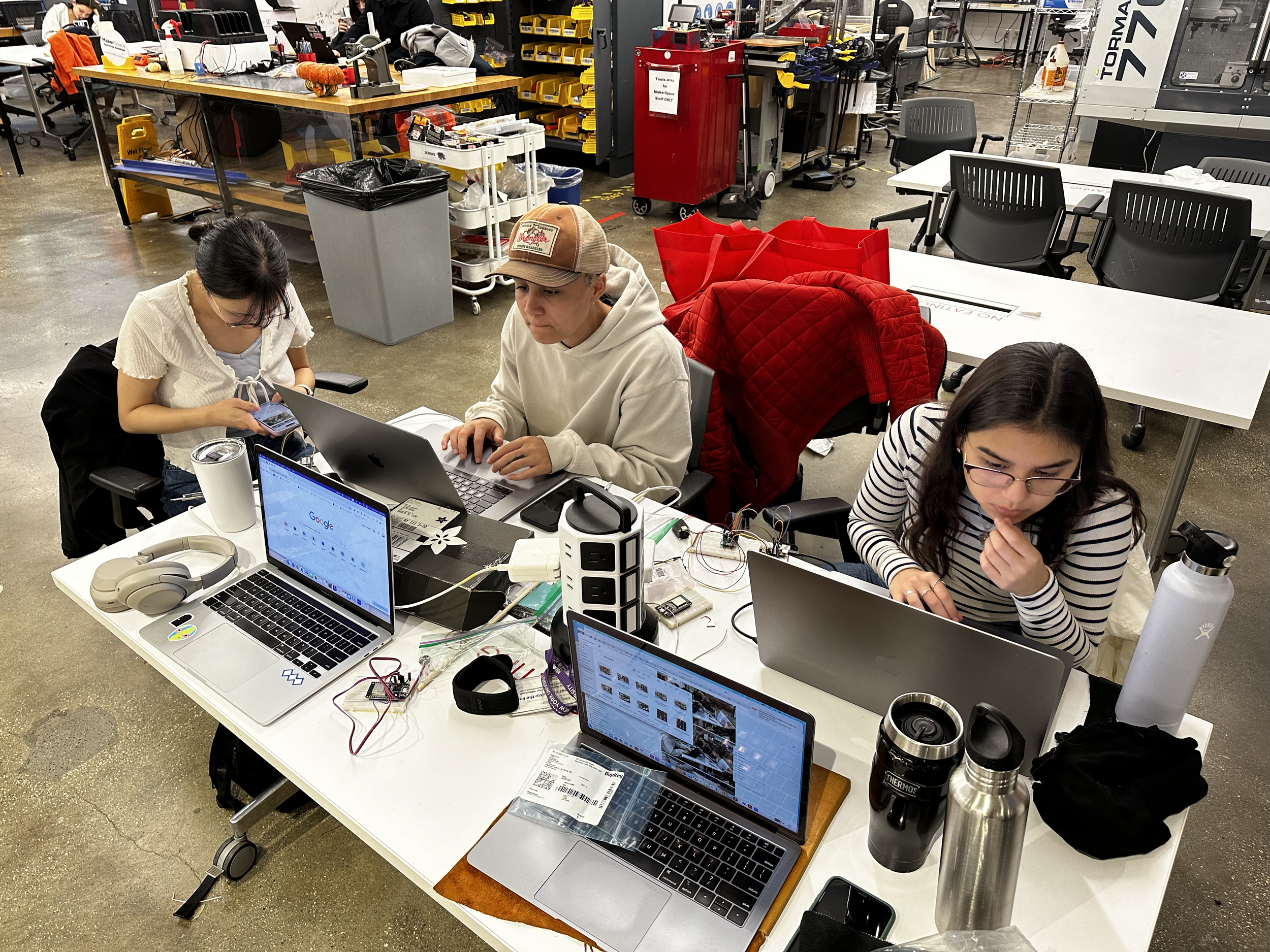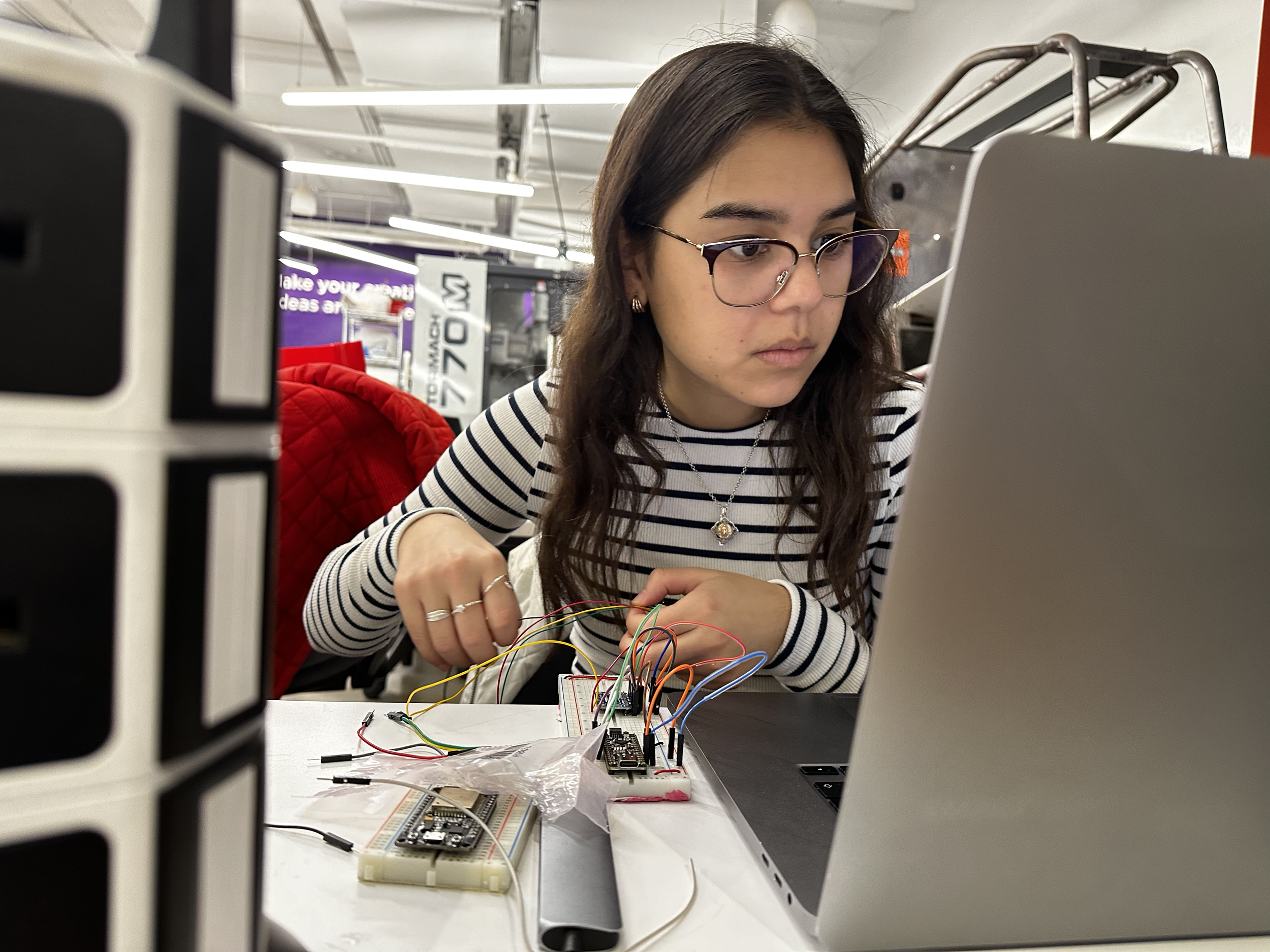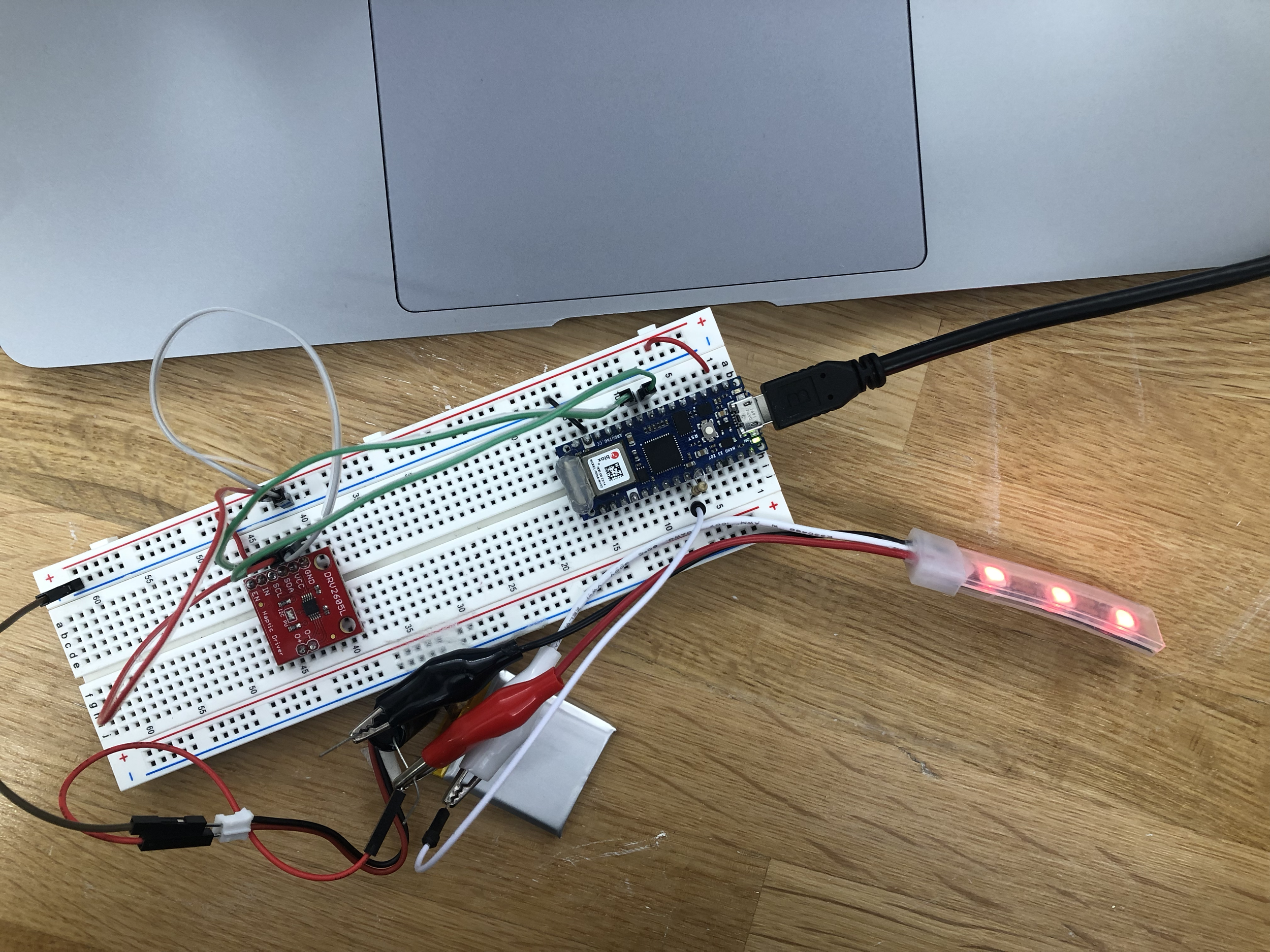
The Sensory Regulation Vest
a product prototype exploring multi-sensory design through the ‘touch’ sense
TEAM:
Designers:
J Sparer (research, code, fabrication, final video editing + captioning)
Ploy Pruekcharoen (research, code, prototype fund application writer, publication writer)
Jimena Suarez (research, code, fabrication)
Andriana Mereuta (code, fabrication, research, project documentation)
Instructor:
Lauren Race “Multisensory Design” Class, Fall 2023
The skin is our largest organ, we humans are wrapped in an incredibly complex sheet covered with sensors. The skin’s layers contain hundreds of thousands of receptor cells, unevenly distributed around the body’s surface. Some shoot the brain signals about temperature or the harmful disruption we perceive as pain. Some seem to specialize in soothing. The areas on the arms and back seem to send signals of pleasure to the brain. Some receptors send the brain the kind of informational detail that helps tell us what we are touching and doing and using. They are called mechanoreceptors - their density is especially high along the palmside skin of the fingertips and hand.
Context comes along: smells, sounds, memory, situational input affects everything. Where our experience come into place.
Touch is our earliest and perhaps our fundamental language of social connection; We humans are believed to have used “tactile communication” before we began figuring out speech.
Touch is now understood to be the first sensation a fetus perceives. Skin to skin touch produces specific, measurable improvements in babies health too: heartbeat, weight, resistance to infection. Babies held skin-to-skin have immediate access to breast milk and can absorb protective maternal microorganism. The physical warmth and touch of a mother/father can keep a newborn alive.
Possible link to the development of the brain (cortical area where touch is registered).
Baby macaques needed “contact comfort” so profoundly that they spurned a steady food source in favor of soft touch.
Rats - gentle strokes - benefits the animals ability to learn and manage stress.
Front view of the vest with Detachable Light Response Indicator (left vest) | Inside - breath monitor, heart monitor. | Wrist sensor has a haptic sensor and an LED light.A mini stepper motor, would go on the back of the vest, which will allow the strings to compress / decompress.Close up demo of the activating mechanism for the sensory vest.
Demo of the vest prototype design.
The vest with the motor to the side and the wrist band with the LED light indicator and heart sensor.
Back view of the vest with the mini motor in the back. A mini stepper motor would go on the back of the vest, which will allow the strings to compress / decompress. An inflatable material is considered as an alternative.Haptic Sensor (inside) + LED light on the surface of the bracelet.Methodology
Number of participants: 5
Location: United States only
Age range: 18-30
Gender: All
Disability Identity: People with high stress levels and/or sensory overload
Experience: No prior experience requirement
Procedure
Data collection: Screening questions, Usability Testing questions, Think aloud protocol
Length: 15-20 minutes
Location: 370 Jay St (3rd and 4th Floor), Mudd Building (Columbia University)
3D resin print of the shaft.
Testing (the code) for the motor tightening / releasing the vest once the heart sensor crosses a predetermined threshold indicating stress / rest state.
Testing the motor in combination with the shaft rotating the excess of fabric to allow for tightening / release of pressure.
MATERIALS:
Pulse Sensor – For use in wristband to measure heart rate data
LED Strip – Lights in wristband will correlate with data received from pulse sensor
Mini Stepper Motors – Will spin to cinch in the cords on both sides of the vest
Metro Mini – Development board
Haptic Motor Controller – Driver for haptic feedback in wristband
Automatic Lacing Device – Used to manually tighten shoe laces, but will be repurposed to be attached to the stepper motor
ESP32 – Development board for bluetooth connectivity between vest and wristband
Breakout Board – Breakout DVR for Motor Controller
LINK TO THE VEST CODE: here
SKILLS:
Arduino/microcontroller programming, sensors, laser cutting, 3D-printing, CNC, paper craft, graphic design, interaction design, and art and crafting skills (textiles, painting, sculpting).
FINAL PROTOTYPE DOCUMENTATION
ACCOLADES:
Our project was recognized and won the NYU MakerSpace and DesignLab Prototyping Fund, Fall 2023. My colleagues from the Tandon School (J, Jimena, Ploy) continued the research work to publish a paper in the industry journals offering this research to other designers who wish to iterate on it. For the pictorial, see here.
Caption: Sensory Regulation Vest Poster, winning project of the NYU Prototyping Fund.
Tested different sizes and materials for the shaft, experimented with hard (resin) / soft materials (TPU). Finally, settled on the resin for reliability.
Caption: (left to right) Ploy, Jimena, Andi, and J.
Demo of the sensory regulation vest final prototype exploring the sense of touch.
PROJECT DESCRIPTION:
In a situation with high stress, sometimes it is hard to communicate with words to those around you that you need time to regulate your anxiety levels. With an automatic monitoring system, your needs are made clear by your body’s response non-verbally. A breathing and/or pulse monitor can trigger an automatic compression system in a vest, activate noise cancelling in headphones, and display an LED indicator to inform you and/or others that you are getting overwhelmed and need stress relief.
Full documentation on the design process can be found here.
Initial Research on Touch Interfaces
Why did we want to design this interface?
16.5% of the general population have symptoms associated with sensory processing challenges, and such estimates get higher for clinical populations, such as autism spectrum disorder and ADHD. Deep pressure therapy has shown to reduce anxiety for individuals with and without Sensory Processing Disorders and be beneficial for babies, in the form of swaddle therapy.
What the user does
Customize the settings of the vest and wristband according to preferences (resting heart rate, threshold for system response, perfered compression settings, LED and haptic toggles).
Wear the vest and wristband (noise cancelling, headphones optional)
Vest can be comfortably worn in most settings / circumstances, would likely be most effective in situations / circumstances that frequently lead to stress for the user, or uncertain / new enviroments that the user may be nervous about.
Heart rate/breathing rate increase = stress response
What the interface does in response
The automated system recognizes stress and responds accordingly
Compression when it senses stress through heart rate/breathing rate
Activate noise-cancelling headphones
Indicates needs through LED activation and/or haptic feedback
What does the interface do well?
Some people may not be able to recognize their needs in a high stress situation (automation).
Caption: National Geographic magazine cover story: “The Power of Touch”
In this class, we took a multisensory approach to design that makes interfaces more accessible to disabled and nondisabled users. We learned how to design for the senses (think tactile controls combined with atmospheric sounds and olfactory or taste experiences), while gaining an understanding of the assumptions we make about our users’ sensory preferences.
When we embarked on our 14-week course, our instructor Lauren Race, invited us to make a team and design an interface focusing on one sense (sight, hearing, touch, taste, smell) that would include at least 3 sensory modalities.
Personally, I was interested in exploring ‘touch’ because so many of our most meaningful experiences and lasting memories can in some way be traced to the feeling of touch. I remembered a story on touch that impacted me, photographed by a dear friend and mentor at National Geographic magazine, Lynn Johnson. Lynn has been dedicated to covering some of the most difficult, sensible, and elusive themes in a way that stirs the human psyche and soul towards empathy and action. Her way of seeing and capturing beyond the visible and graspable is extraordinary. Her mastery inspired me to think how can I explore touch in my own work using a different way of thinking too, using principles of design, art, and technology. So when we made a team, all interested in ‘touch’ as an area of exploration, each had a personal story of why it was important or at least interesting to them; for some it was about a personal struggle/condition with sensory overstimulation, for some a design challenge to solve, for some a research topic to explore, for me it was about designing a product grounded in science and functionality, wrapped in beauty and creative design, and serving the wellbeing of another in a direct and ‘touch-able’ manner.
RESEARCH
Why is TOUCH so important?
Sense of touch is essential to our mental health to feel connected, it also gives us information about the things around us, thanks to the thousands of nerve fibers on our skin and millions of neurons in the brain.
PROTOTYPING
Our second week consisted on brainstorming existing ideas we had on possible projects we could do. We chose 3 projects that enhance touch sense together with sound, sight and possibly smell.
Sensory Overload System
Touch + Sound + Sight
What the user does
Heart rate / breathing rate increase = stress response
What the interfaces does in response
Automated system recognizes stress and responds accordingly
Compression when it senses stress through heart rate / breathing rate
Indicates needs through light activation
Activate noise-cancelling headphones
What does the interface do well?
Some people may not be able to recognize their needs in a high stress situation (automation)
What does it not do well?
Compression vests are not a universal solution for sensory processing management
Mixed results for processing disorders in studies
Visibility / privacy
ITERATING
Taking feedback into consideration, these were some of the things we prioritized moving forward:
Prioritizing Privacy
We want our users to have complete control of their experiences, this includes ensuring the system can be customized for discretion.
Wearables can often be clunky and cumbersome so we are aiming for the vest to be slim and able to be worn under clothing.
The system will incorporate some sort of notification system through light or haptic feedback. If the light is on the vest itself, it can be turned off or removed. If it is part of the accompanying wristband, it can be customized or turned off as well. And if it is haptic, we would ensure it is quiet and subtle.
A notification system could be important for a caretaker for example, but privacy is still crucial, and we aren’t specifically targeting a user base of people with caretakers.
Any sounds emitted from the vest will be minimal
Customization
Just like privacy customization, we also want to ensure safety. Customization is a huge aspect of a successful tool.
Any compression action taken by the vest will need to have customizable parameters / threshold because every user is different and wants different things – the level of pressure one user enjoys might be too intense for another.
The compression level can also be a safety issue. Prolonged high pressure could restrict breathing or circulation. Certain parameters need to be set to regulate this.
Some users might have a different resting heart rate or breathing rate that is comfortable for them, by allowing them to set their own parameters of what is natural for them, we can ensure the system is responding appropriately to their needs.
Texture / Material
We are searching for the most comfortable and safe materials to use for the vest.
We need to consider whether this vest requires direct skin contact, or if there can be a layer underneath to allow users to choose what is most comfortable for them.
DESIGN INSPIRATION
PROCESS
To build our prototype we used colored paper for the vest and the bracelet, colored tape to imitate the LED strip on both, foam core for the bracelet haptic sensor, and thread around a piece of cardboard in the back of the vest for the motor. The motor will activate the vest to either inflate (if we'll use such a system) or adjust the strings on both sides of the vest (i.e. Nike shoe) to compress against the body enough to make the person comfortable.
Demo of the rapid prototype process.
Usability Testing
Based on our research goals, we decided to create a new prototype made of stretchy fabric to enhance the experience of the vest prototype for our usability testing.
Usability Testing Findings
After we conducted usability testing, our team listed the key insights and created an affinity diagram. Below are the key findings:
Background and Experience
3/5 participants experience sensory overload when they’re in a crowded space.
When there are too many tasks going on at once.
Public events, raging events
Enclosed spaces trigger stress.
Each participant has different tools that they’re currently using to manage stress caused by overstimulation.
2/5 participants talked to friends about it after the situation was over.
2/5 participants used noise-cancelling headphones.
Others also mentioned different activities, e.g., meditation, swimming, knitting, and watching Netflix.
Design of the Vest
Each participant prefers different types of fabric and the appearance of the vest.
2/5 participants prefer the vest to be on their skin.
1/5 participant prefers the vest to be wear in between the inner and outer layers of their clothes
2/5 participants prefer the vest to be outerwear
Each participant have different preferences for fabric, e.g, thin and stretchy, thick and puffy, or customizable.
3/5 participants don’t want the LED to be visible to others, one finds it helpful, while the other doesn’t feel any difference.
The participants who don’t want the LED to be visible to others mentioned that they don’t want to be noticed or have others know that they’re experiencing stress.
The participant who finds the LED helpful mentioned that when they’re in a crowded space, it would be easier for them to be evacuated.
Each participant likes different aspects of the vest.
One participant liked the feeling when the vest gets compressed, one didn’t like it, while the others didn’t feel any differences.
2/5 participants liked that the vest is connected to the noise-cancelling headphones.
1/5 participant liked the haptic feedback, 2/5 participants were okay with it, while the other 2/5 participants mentioned that the haptic feedback could trigger more overstimulation.
Demo of the iterated prototype based on user testing feedback.
Testing:
Testing for the haptic sensor designed to be placed inside the wrist band.
Testing (the code) for the heart sensor. To be used in combination with the LED indicator on the wrist.
Testing (code) for the LED light which is connected to the heart sensor and indicates the shift in heart rate. Also connected to the wrist band.
































































